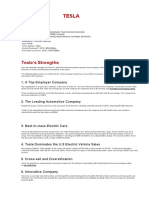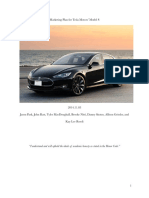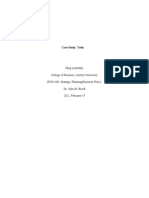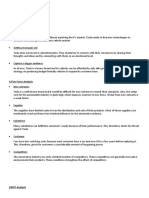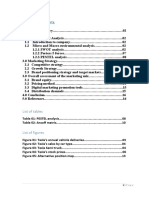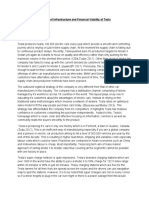Tesla Strengths - Internal Factors
Tesla Strengths - Internal Factors
Uploaded by
Quỳnh TrangCopyright:
Available Formats
Tesla Strengths - Internal Factors
Tesla Strengths - Internal Factors
Uploaded by
Quỳnh TrangOriginal Title
Copyright
Available Formats
Share this document
Did you find this document useful?
Is this content inappropriate?
Copyright:
Available Formats
Tesla Strengths - Internal Factors
Tesla Strengths - Internal Factors
Uploaded by
Quỳnh TrangCopyright:
Available Formats
Tesla Strengths – Internal Factors
Innovation
Tesla is an innovator continues to invest heavily in research and development. In 2019,
Tesla invested $1,343 million into advancing its product and services.
It’s worth mentioning that Elon Musk will cross-fertilize ideas and innovations from his
other companies such as Space X. While there might not think there are any obvious cross
over, new materials and software could well benefit Tesla.
In terms of innovation, BCG ranked Tesla the 9th most innovative brand in 2019
Leading Sales of Electic Cars
Over 2019, if you look at Tesla’s market share of the U.S. automotive market it might
seem disappointing at just over 1.3 per cent.
However, if you just look at the U.S. electric vehicle (EV) market, Tesla is the clear market
leader in battery-electric car sales for the United States. In 2019, it sold over 192,250 cars
while its nearest rival Chevrolet sold jus 16,418 units.
In fact, as of March 2020, Tesla has sold over 1 million vehicles.
Brand and Marketing
Tesla has become synonymous with luxury sports cars. By starting off at the luxury end of
the car market, Tesla was able to craft the brand as a luxury car. Lower priced and more
mass cars like the Model 3 though benefit from the halo effect of the brand
For a company that spends zero dollars on advertising it has become a globally
recognized brand not least because of Elon Musk. Other car companies collectively spend
around $14 Billion on marketing every year – just in the US.
Partners
Tesla has developed a network of global partnerships which help with the R&D costs,
distribution and of course charging points.
Tesla has a whole ecosystem of charging partners such as hotels, resorts, service centres
and shopping malls.
Design
I would go so far as to say that Tesla is the Apple of the car world. I’m not comparing
Steve Jobs to Elon Musk, although that might be interesting. At the heart of both companies
is the attention to detail, the customer experience and the design of the products – end-to-
end design.
Design means listening to customers not necessarily taking on-board everything they
feedback but realising when you need to make improvements and then doing something
about it. Elon Musk is famous for replying to customers on their feedback and making
changes.
Elon Musk
Elon Musk is loved by the media because he is unconventional and controversial. He
creates headlines which in turn generate publicity and lots of it. Sometimes wiping as much
as $15 billion off the value of Tesla but other times equally boosting it.
He has fans – lots of them – on Twitter alone he has 33M followers many of which are
devoted fans – reminiscent of the same adoration that Steve Jobs attracted.
Tesla Weaknesses – Internal Factors
Manufacturing
Tesla has had problems and complaints about the standards of its manufacturing.
Elon Musk has been know to camp out near factories to try and thrash out factory issues.
As CEO, this must strain his attention from running Tesla, as well as Space X.
Financial Performance
Tesla has a high negative P/E ratio, reflecting investors’ faith in its future earnings despite
regular losses.
Tesla has also benefited from huge incentives at national and state level through to tax
credits for consumers. Some have criticized this and reflected on Tesla’s inability to still turn
a profit. In defence, Tesla has said it has succeeded despite these benefits, not because of
them.
Tesla’s market cap reflects investors belief in its long-term success, but many remain
sceptical – if you look at its market cap vs market share you could be forgiven for thinking
the stocks are overpriced. However, many view these stocks as similar to other more tech-
based startups that also have high valuations and high P/E ratios.
Batteries
The two criticisms being levelled at Tesla over its batteries are not directly related. The
first is more about ownership of a Tesla car. Accepted that batteries capacity to recharge
diminishes over time which affects distances covered before a charge is needed.
The other weakness though is related to production – namely that Tesla depends on
batteries which in turn depend on elements like lithium and there are only limited supplies
of these.
Fun fact: Tesla became the world’s biggest battery consumer just a few years after
achieving volume production of its electric vehicles.
One Man Show
Elon Musk takes centre stage – often that ‘s a good thing. However, as a large and
growing multinational company, it could do with more leaders who are less distracted. The
clear danger is that if you take Elon Musk out of the equation would investors feel as secure
– I doubt it!
High Levels of Debt
The high levels of debt relative to sales and overall performance do not marry up with
other companies in the sector. Furthermore, Tesla is a relatively young company in the car
industry and has yet to secure its position across the main geographical territories.
Of particular worry is the other divisions of Tesla that are not performing least of which is
the troubled SolarCity project which Tesla purchased for $2.6 billion.
At some point, the debt will need to repayment and that looks unlikely in the
foreseeable future.
Lack of Capacity
Car manufacturers depend on achieving economies of scale to make profits. Tesla needs
to secure and deliver car production across a broader set of geographical territories if it is to
achieve scale. That means it needs to secure more production not only in China but also
more in Europe.
Market Focus
The Tesla Model 3 is more mass-market than the Model S but it is still priced above the
main volume in the car market. If Tesla is to achieve higher volumes and go head-to-head
with brands like Audi and Mercedes then it needs a mid-market product.
Tesla Opportunities – External Factors
International Expansion
Tesla has factories in Freemont, US; Tilburg, Netherlands, Berlin, Germany and Shanghai,
China.
The factory in Germany is set to open in 2021 and will produce the Model 3 range of cars
Despite these it is perhaps the Asia market that holds the greatest potential. Competitors
like Audi are realizing the benefit of expanding in China reaching much higher volumes than
Tesla.
Mid-Market Car Range
The mid-market car sector is critical for volume and also the fleet car sales.
Tesla can exploit its base to produce lower priced mid-market cars that drive higher
volume and adoption rates.
Battery Production In-house
Tesla can change from using Panasonic to make its batteries to making its own.
This could open up new revenue opportunities by suppliers other car makes.
This would alleviate problems with supply and help the company to increase its
production rates.
Expand Ecosystem
Tesla could expand its charge point infrastructure either through further partnerships or
even acquisitions.
this could provide useful protection against competitors and provide further data as well
as revenue from the infrastructure e.g. offer Tesla car owners beneficial charge rates but
charge competitors a percentage commission for using the infrastructure.
Corporate Fleets
Corporates are increasingly having to account for their global carbon footprint as well as
develop more sustainable solutions.
Although many corporates have a corporate statement, they have yet to translate these
into action when it comes to var fleets. However, there is growing demand from
shareholders for greater transparency and more action.
Tesla is well placed to become a suitable car choice for fleet cars if it can produce a
broader range that will fit to the budgets for mid-management.
Government Incentives
The growing urgency of various governments to accelerate their policies towards a
cleaner environment has increased the demand for zero-emission vehicles. Developed
nations such as the US, Germany, and the UK are promoting the use of electric vehicles to
reduce emissions, which has resulted in the growth of electric vehicle sales.
This trend though could accelerate as other nations also adopt policies and offer
incentives to customers.
Tesla Threats – External Factors
Competition
The giants in the automotive industry might have underestimated Tesla, but they have
now woken up and are investing heavily in electric and digital technologies
It’s important to recognise their size and presence, particularly in the US market which is
probably the most competitive market for Tesla
The big players still have a considerable amount of market share, the capital to invest
heavily in electric and digital technologies
As an example, General Motors is investing $20 billion into autonomous vehicles – that’s
roughly 15x Tesla’s R&D budget
Product Liability Claims
Despite Tesla’s premium quality assurance, it is facing significant product liability claims
which could lead to a big financial penalty.
Tesla has launched many autopilot vehicles, and not all of them have been successful.
The company has faced lawsuits and claims related to the failure of technology including
cars set on fire. If these liability claims continue, then Tesla may be subjected to greater
financial setbacks.
China Market
Even in China Tesla has a long way to to go to catch to the same volumes as to its
competitors.
The coming years will be a test of how well Tesla performs in this crucial market.
Substitutes
As cities get more congested new regulations and policies could change and lead to more
dramatic shifts in how we tackle pollution and congestion problems. More cities may ban
cars and force the use of public transport systems.
The sharing economy has grown and become a growing trend, particularly among
younger generations. With the high cost of living in cities and the trend towards city living,
sharing vehicles might be the new normal.
Luxury cars might not fit into this model though.
Lack of Critical Materials
Tesla uses lithium-ion cells in their battery packs but global demands increasing as other
car manufacturers ramp up their electric vehicle production.
Tesla could face disruptions in the supply of these vital raw materials due to the
increased prices as well as in other vital elements needed for batteries e.g. nickel, copper,
and cobalt. All these materials could affect the company’s production line severely in the
future.
Regulatory Changes
Currently, there are no regulations for self-driving vehicles in the majority of countries,
including the US. Tesla’s though is continually pursuing this as part of its overall strategy, in
other words as a competitive edge. However, by the time regulations come into play to
allow autonomous vehicles others car producers could have the same or similar technology.
=> The Tesla SWOT analysis shows that the biggest threat comes from competitors. Tesla’s
competitors ready have strong infrastructure, distribution and models that they can
transform to electric. This would secure sales and limit Tesla’s growth.
You might also like
- Tesla's Competitive StrategiesDocument17 pagesTesla's Competitive StrategiesMorenti RegoNo ratings yet
- Tesla's StrengthsDocument4 pagesTesla's Strengthsnarmin mammadliNo ratings yet
- Team Seven Case StudyDocument52 pagesTeam Seven Case Studyapi-543052211No ratings yet
- Tesla - Model 3 - Final Marketing Plan - Joshua LewisDocument27 pagesTesla - Model 3 - Final Marketing Plan - Joshua Lewisapi-304798874No ratings yet
- Tesla Inc PESTEL and PorterDocument2 pagesTesla Inc PESTEL and PorterHobilla Penchy80% (5)
- Market Entry Strategy QUESTION + ANSWERDocument11 pagesMarket Entry Strategy QUESTION + ANSWERkhrisna02No ratings yet
- Tesla Motors Case StudyDocument2 pagesTesla Motors Case Studythomas alvarezNo ratings yet
- DDocument20 pagesDHead External Relations CLP Center LTSU PunjabNo ratings yet
- Tesla's Transition From Niche To MainstreamDocument6 pagesTesla's Transition From Niche To MainstreamRiturajPaulNo ratings yet
- Marketing Plan For Tesla Motors' Model SDocument21 pagesMarketing Plan For Tesla Motors' Model SPranav TripathiNo ratings yet
- Phase 1 Group 41 MarketingDocument6 pagesPhase 1 Group 41 MarketingPeyton BurgerNo ratings yet
- Tesla April 2024Document6 pagesTesla April 2024guangzhenlNo ratings yet
- Peer-Graded Assignment - Competitive Position Assignment: Tesla, IncDocument13 pagesPeer-Graded Assignment - Competitive Position Assignment: Tesla, Incharsh inaniNo ratings yet
- Analysis of Tesla Inc. 1Document12 pagesAnalysis of Tesla Inc. 1nick2020No ratings yet
- Business IaDocument11 pagesBusiness IamohamamdNo ratings yet
- Market Strategies of TeslaDocument6 pagesMarket Strategies of TeslaMd. Asiqul AlamNo ratings yet
- Competitive Adv. TeslaDocument10 pagesCompetitive Adv. TeslaAmartyaNo ratings yet
- Case Study: TeslaDocument12 pagesCase Study: TeslaOleg LozytskyiNo ratings yet
- Case StudyDocument7 pagesCase StudyBIJJULA LAKSHMI SRAVANINo ratings yet
- Strengths.: Tesla Has Multiple Strengths Which Are Major Contributing Factors in The Company'sDocument7 pagesStrengths.: Tesla Has Multiple Strengths Which Are Major Contributing Factors in The Company'sIMRAN ALAMNo ratings yet
- The Tesla Business Model Operates As A DirectDocument11 pagesThe Tesla Business Model Operates As A Direct6py9smqckqNo ratings yet
- A Case Study On TeslaDocument11 pagesA Case Study On TeslaJemar MarquezNo ratings yet
- Tesla Inc. Company AnalysisDocument12 pagesTesla Inc. Company Analysisr.saran152006No ratings yet
- Tesla Motors: Name: Robin Gupta IAP Roll No. 71Document6 pagesTesla Motors: Name: Robin Gupta IAP Roll No. 71Robin GuptaNo ratings yet
- SWOTANALYSIS Tesla HarvardStrategicManagementDocument3 pagesSWOTANALYSIS Tesla HarvardStrategicManagementTuấn Minh LêNo ratings yet
- Case Study TeslaDocument2 pagesCase Study TeslaNey JNo ratings yet
- Marketing Strategy TeslaDocument16 pagesMarketing Strategy TeslaPrabath MadusankaNo ratings yet
- IMC - MKT695 - Tesla Model S - CA3 - 11401105Document13 pagesIMC - MKT695 - Tesla Model S - CA3 - 11401105Mohith DasNo ratings yet
- (USA Today 2017) - (Inside EV 2017) .: Analysis of Infrastructure and Financial Viability of TeslaDocument4 pages(USA Today 2017) - (Inside EV 2017) .: Analysis of Infrastructure and Financial Viability of TeslaAli Zain BhattiNo ratings yet
- Corporate Strategy Case StudyDocument7 pagesCorporate Strategy Case Studyricharddocks0223No ratings yet
- Contemp Project Model-Gov8Document19 pagesContemp Project Model-Gov8Ahmed Mohamed Walid100% (1)
- Case Study Tesla: Luan DedaDocument11 pagesCase Study Tesla: Luan DedaLuan M. DedajNo ratings yet
- Case Study TESLADocument13 pagesCase Study TESLADamien MoriceNo ratings yet
- FulltextDocument19 pagesFulltextMohamed NourNo ratings yet
- Innovation MananagementDocument36 pagesInnovation MananagementelyoubiinaamNo ratings yet
- Research On The Tesla's Business Model AnalysisDocument8 pagesResearch On The Tesla's Business Model AnalysisnanabhauNo ratings yet
- FINAL Tesla CompanyDocument9 pagesFINAL Tesla Companystephen changayaNo ratings yet
- By-Megha Bandhav Kilaru Dhanush Goud Chetan Akula Santhosh Dheeraj Hari HaranDocument11 pagesBy-Megha Bandhav Kilaru Dhanush Goud Chetan Akula Santhosh Dheeraj Hari HaranMegha Bandhav KilaruNo ratings yet
- Tesla Project ReportDocument20 pagesTesla Project ReportMahesh Kharat100% (1)
- TeslaDocument8 pagesTeslaramanpreet100% (1)
- Case Study - Tesla (Ha-Phong Nguyen, Anyss Khalfa, Hamza Sehaqui, Ilias Nafaï and Yann Rambeau)Document20 pagesCase Study - Tesla (Ha-Phong Nguyen, Anyss Khalfa, Hamza Sehaqui, Ilias Nafaï and Yann Rambeau)hapho90No ratings yet
- Session 13Document17 pagesSession 13Megha GautamNo ratings yet
- MSL 711 Strategic Management: Tesla Case StudyDocument5 pagesMSL 711 Strategic Management: Tesla Case StudyRia SinghNo ratings yet
- Tesla Marketing Case Study: By: Muhammad Eddieb Supervised By: Dr. Reham Moawad 12/21/2018Document15 pagesTesla Marketing Case Study: By: Muhammad Eddieb Supervised By: Dr. Reham Moawad 12/21/2018prateek0% (1)
- TeslaDocument2 pagesTeslajesperandersson.09No ratings yet
- Avoidance of Second BankruptcyDocument49 pagesAvoidance of Second BankruptcySueliaNo ratings yet
- Marketing Management - Integrated Marketing Channels and Distribution SystemDocument10 pagesMarketing Management - Integrated Marketing Channels and Distribution Systemজয়দীপ সেনNo ratings yet
- Tesla Motors Shelby LeeDocument13 pagesTesla Motors Shelby Leeflh21gmail100% (1)
- Case Study 2Document4 pagesCase Study 2Mansura Nur MowNo ratings yet
- Caso Tesla EnglishDocument14 pagesCaso Tesla EnglishVinícius Gregório BeruskiNo ratings yet
- Tesla Business Report (AutoRecovered)Document15 pagesTesla Business Report (AutoRecovered)Antara SarkarNo ratings yet
- Tesla CaseDocument2 pagesTesla CaseTanvir Hasan0% (1)
- Marketing PlanDocument17 pagesMarketing PlanHoàng Anh VũNo ratings yet
- Abdullah Saleem 15223 MP Assignment Tesla vs. AppleDocument2 pagesAbdullah Saleem 15223 MP Assignment Tesla vs. AppleAbdullah SaleemNo ratings yet
- Fundamental Principles of Strategy and Business Policy: Strategic Management ProjectDocument11 pagesFundamental Principles of Strategy and Business Policy: Strategic Management ProjectAmit GroverNo ratings yet
- PH.D. Program in Business and Management Qualification Exam For Advanced Management Theories Student: Anu Kanwar Student ID: DA81G207 QuestionsDocument28 pagesPH.D. Program in Business and Management Qualification Exam For Advanced Management Theories Student: Anu Kanwar Student ID: DA81G207 Questions柯孟穎No ratings yet
- Tesla Motors Strategy To Revolutionize TDocument15 pagesTesla Motors Strategy To Revolutionize TBharat VarmaNo ratings yet
- Lavish Yadav ProjectDocument83 pagesLavish Yadav Projectsmartzonecsc.govNo ratings yet
- Tesla Marketing PlanDocument17 pagesTesla Marketing PlanpmNo ratings yet
- Chemistry For CSEC Second Edition Anne Tindale Ebook All Chapters PDFDocument62 pagesChemistry For CSEC Second Edition Anne Tindale Ebook All Chapters PDFdefauxhalawi100% (15)
- ENSCO Track Inspection Products Services Booklet 2022 6905 2Document37 pagesENSCO Track Inspection Products Services Booklet 2022 6905 2acdiesel111No ratings yet
- Steps in Planned ChangeDocument2 pagesSteps in Planned ChangePiana Monsur Mindia100% (1)
- Peer-to-Peer Lending in India: An Industry AnalysisDocument12 pagesPeer-to-Peer Lending in India: An Industry AnalysisAnnie SNo ratings yet
- MS-Accountancy-12-Practice Paper 2Document9 pagesMS-Accountancy-12-Practice Paper 2im subbing to everyone subbing to meNo ratings yet
- Jurnal Penulisan Karya Ilmiah B. InggrisDocument8 pagesJurnal Penulisan Karya Ilmiah B. InggrisSekar SariNo ratings yet
- RCBC Cars For Auction - Head Office & Provincial Units As of Nov 23 - 27,2020Document2 pagesRCBC Cars For Auction - Head Office & Provincial Units As of Nov 23 - 27,2020Arfil Sta Ana YongcoNo ratings yet
- ML145 - EN ManualDocument20 pagesML145 - EN ManualFabio UnruhNo ratings yet
- Full Manual: HW-Q950ADocument70 pagesFull Manual: HW-Q950AspborikarNo ratings yet
- Naveena Guntupalli ResumeDocument6 pagesNaveena Guntupalli ResumeSurendranath Reddy BirudalaNo ratings yet
- Creativity and InnovationDocument20 pagesCreativity and Innovationhelp.questions.twNo ratings yet
- Decorations For Ramadan Beautiful & Fun Decor IdeasDocument1 pageDecorations For Ramadan Beautiful & Fun Decor IdeasKhadija AliouatNo ratings yet
- Conversatie, Exemple Exercitii, Traduceri: Exercitii, Traduceti in Romana, Traduceti in Engleza, Ghid Roman-EnglezDocument2 pagesConversatie, Exemple Exercitii, Traduceri: Exercitii, Traduceti in Romana, Traduceti in Engleza, Ghid Roman-EnglezcomecNo ratings yet
- ASM Material Data Sheet 304Document2 pagesASM Material Data Sheet 304.xNo ratings yet
- TTO Standard Flat Pack Bracket Assembly Manual EnglishDocument48 pagesTTO Standard Flat Pack Bracket Assembly Manual EnglishKiran RagooNo ratings yet
- List of Bidders: Suntrust The Mist Residences Aspiras-Palispis Highway, Corner Atab W Road, Bakakeng Central, Baguio CityDocument9 pagesList of Bidders: Suntrust The Mist Residences Aspiras-Palispis Highway, Corner Atab W Road, Bakakeng Central, Baguio CityGiovanni TandogNo ratings yet
- Easement NotesDocument7 pagesEasement NotesGhosn40% (1)
- Uv8378 PDF EngDocument17 pagesUv8378 PDF EngscarlettsmlauNo ratings yet
- SlinkyDocument14 pagesSlinkypusicantonijeNo ratings yet
- Vacon NX, Non-Regenerative Front End FI9 UD01217B PDFDocument48 pagesVacon NX, Non-Regenerative Front End FI9 UD01217B PDFSilvian IonescuNo ratings yet
- Of Rope: For Large Mine Cars With Roller BearingsDocument5 pagesOf Rope: For Large Mine Cars With Roller BearingsJayati GuptaNo ratings yet
- Synopsis of Customer Acquisition and Retention StrategyDocument9 pagesSynopsis of Customer Acquisition and Retention StrategyGopi Krishnan.nNo ratings yet
- Case Study On Sab Miller IndiaDocument163 pagesCase Study On Sab Miller Indiaசக்தி தாசன்No ratings yet
- E24 - PT#033.0905Document4 pagesE24 - PT#033.090512345673532No ratings yet
- Transistors Notes 4Document13 pagesTransistors Notes 4Anil Sai100% (1)
- Bijupatnaikuniversity of Technology, Odisha: Curriculum and SyllabusDocument23 pagesBijupatnaikuniversity of Technology, Odisha: Curriculum and Syllabusdilliprout.caplet2016No ratings yet
- National IMAM Guideline 15 February 2018Document160 pagesNational IMAM Guideline 15 February 2018Satrumin ShirimaNo ratings yet
- VSM5J - Datasheet (Low) - LG Video Wall - 220321 (20220324 - 095503)Document6 pagesVSM5J - Datasheet (Low) - LG Video Wall - 220321 (20220324 - 095503)Arvans AGNo ratings yet
- Case Study - Persuasive WritingDocument5 pagesCase Study - Persuasive WritingKari MichaelNo ratings yet

